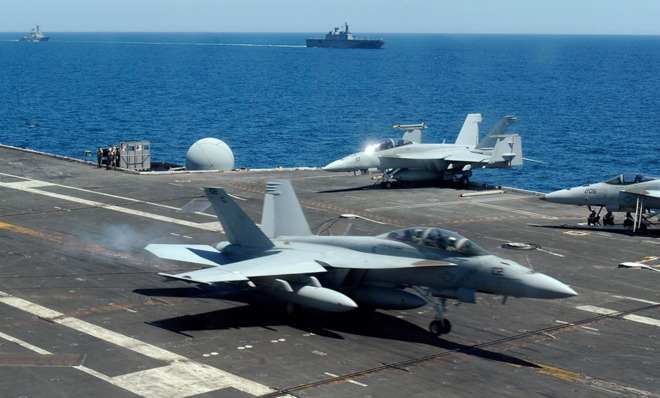Why China thinks it could defeat the U.S. in battle
To beat China, the Pentagon needs more drones, missiles, and subs


For the first time since China's rapid ascent as a regional military power, officers in Beijing believe the Chinese army could invade Taiwan or attack a disputed island while also deterring intervention by U.S. Pacific Command.
In other words, top Chinese military planners are now convinced they could defeat the United States. And some American thinkers are coming to believe the same thing.
"U.S. forces in the region are becoming increasingly vulnerable to China's anti-access capabilities," David Gompert, a former Acting Director of National Intelligence now working for the think tank RAND, told the U.S.-China Economic and Security Review Commission in Washington, D.C. on Jan. 30.
The Week
Escape your echo chamber. Get the facts behind the news, plus analysis from multiple perspectives.

Sign up for The Week's Free Newsletters
From our morning news briefing to a weekly Good News Newsletter, get the best of The Week delivered directly to your inbox.
From our morning news briefing to a weekly Good News Newsletter, get the best of The Week delivered directly to your inbox.
"This creates the prospect of regional instability, loss of U.S. influence, and heightened threat of conflict," Gompert warned.
But the Pentagon could shift the power balance back in America's favor, Gompert said. He argued that a "less vulnerable U.S. posture" should include submarines, long-range bombers, drones, and swarms of missiles and small warplanes.
The idea being to launch attacks from far outside China's defensive cordons — and spread out and conceal U.S. forces in order to complicate Beijing's targeting.
The good news for Washington is that the military is already hard at work on many elements of this "distributed" strike construct — with just one glaring exception.
A free daily email with the biggest news stories of the day – and the best features from TheWeek.com
While the Pentagon is getting new and improved submarines, new bombers, more and better drones, and plenty of missiles, it's not about to expand its fleets of warplanes. At least not manned planes.
In fact, America's air arms are getting smaller as they shift to bigger, heavier, and pricier jet fighter designs — the exact opposite of the aerial swarms Gompert advocated.
Strike net
Apparently guided by a classified strategy known as AirSea Battle, the U.S. Navy and Air Force are steadily building up the very kinds of forces that Gompert contended are best suited to defeat China's own massed missiles, planes, and ships.
In 2012, the Navy reversed a long-term decline in its submarine production by buying two subs in one year for just over $2 billion apiece. That manufacturing scheme, known inside the Navy as "two for four in '12," should preserve America's undersea lead.
The Navy is projected to possess between 60 and 70 nuclear-propelled subs for at least the next couple decades. No other country has even half as much undersea combat power.
Moreover, Connecticut sub-maker Electric Boat has worked closely with the Navy to steadily improve the current Virginia-class submarine design. With every "block" of 10 or so boats, the Virginias get big upgrades.
The Block V boats, scheduled to being production in 2019, will carry an extra 28 cruise missiles on top of the 12 missiles in the current sub model. The Virginias and America's other submarine classes could also soon gain the ability to launch flying recon drones from underwater concealment.
In December, the Naval Research Laboratory successfully launched a fuel-cell powered drone from the torpedo tube of the submerged USS Providence. The drone is encased in a buoy that, after blasting from the torpedo tube, bobs to the surface and pops out the flying robot.
The 'bot could follow GPS coordinates and communicate with the sub periodically via radio, connecting by way of the submerged boat's mast, poked above the waves only as long as possible to avoid detection.
Adding these drones to the missile-equipped subs could allow undersea forces to independently find their own targets. In a war with China, U.S. subs could be the first and main weapon for breaking up Chinese defenses, allowing other forces — bombers and warships — to safely hit targets.
In particular, the subs would need to take out the radars associated with China's Surface-t0-Air-Missiles. "An organic [Unmanned Aerial System] will provide submarines a fully organic capability to detect, identify, precisely locate and quickly strike modern SAM engagement radars," Owen Cote, a naval analyst at the Massachusetts Institute of Technology, wrote in a 2011 paper.
To then exploit the holes poked in Chinese defenses by subs and drones, the Air Force is developing the new Long-Range Strike Bomber for service starting in the 2020s.
Based in the U.S. and at America's main heavy warplane outpost in Guam, up to 100 of these bombers — successors to the Air Force's 20 B-2 stealth bombers — would work in conjunction with new, radar-evading spy drones to further pinpoint targets than blast them with precision weapons.
Not coincidentally, according to Aviation Week the Air Force is wrapping up final testing of the top-secret RQ-180, a long-range, radar-evading robot built by Northrop Grumman.
Between them, the improved subs with their drones and extra missiles, plus the Air Force's planned fleet of drone-assisted new bombers, begin to match Gompert's vision for a "less vulnerable U.S. posture" for battling China.
Only one piece is missing — "larger numbers of diverse and smaller … aircraft platforms." Instead of acquiring large numbers of inexpensive warplanes to swarm enemy defenses, the Pentagon — and especially the Air Force — is buying many fewer new jet fighters at greatly increased cost.
Even under the most optimistic scenario, in the 2030s the Air Force will have spent $500 billion over 30 years to acquire just 1,763 F-35 Joint Strike Fighters and 182 F-22 Raptors — 1,945 fighters to meet a requirement for fighters that, as recently as 2009, stood at 2,200 airframes.
When it comes to tactical jets, the Air Force is shrinking and concentrating, not expanding and spreading out, as Gompert recommended.
Gompert stressed that a new, more distributed U.S. Pacific force should not be understood as necessarily threatening China. "Rather, by facing China with a more complex targeting challenge, it would discourage Chinese preemptive attack, obviate the need for U.S. preemptive attack, and allow time to defuse a crisis."
While Air Force fighters are an exception, the flying branch does seem to be taking that advice to heart with regard to heavy bombers. The Navy, too, is gearing up to more effective deter China.
From drones to AKs, high technology to low politics, War is Boring explores how and why we fight above, on, and below an angry world. Sign up for its daily email update here or subscribe to its RSS Feed here.
More from War is Boring...
-
 Received a gift card this holiday season? Here’s how to maximize it.
Received a gift card this holiday season? Here’s how to maximize it.The Explainer Make the most of your present
-
 ‘Lumpy skin’ protests intensify across France as farmers fight cull
‘Lumpy skin’ protests intensify across France as farmers fight cullIN THE SPOTLIGHT A bovine outbreak coupled with ongoing governmental frustrations is causing major problems for French civil society
-
 The best books of 2025
The best books of 2025The Week Recommends A deep dive into the site of a mass shooting, a new release from the author of ‘Atonement’ and more